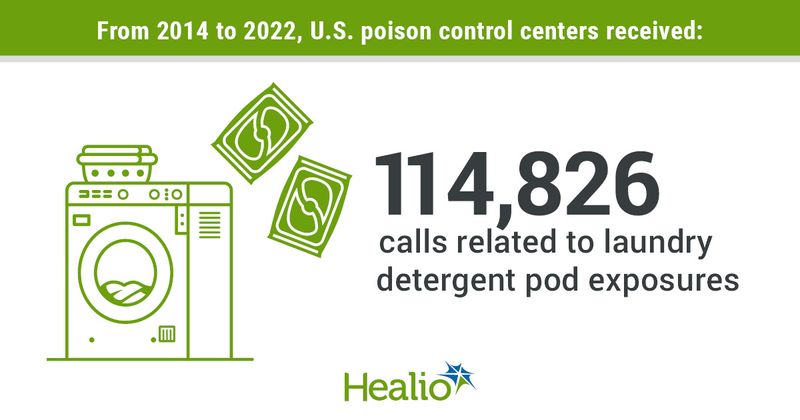Children still exposed to laundry detergent pods at high rate
Key takeaways:
- From 2014 to 2022, there were more than 114,000 calls to U.S. poison control centers related to laundry detergent pods.
- Exposures among the youngest children have declined in recent years.
Calls to poison control centers to report exposures to liquid laundry detergent packets — commonly called pods — remain high in the United States, although exposures appear to have declined among young children, researchers reported.
One of the researchers told Healio that the study was inspired by an interest in consumer product safety and in preventing child injuries and poisonings.

“We had done earlier work looking at laundry detergent packets — almost 8 to 10 years ago when they first started to come out on the market — and that's when we recognized that they were a poisoning hazard for young children,” Christopher Gaw, MD, an emergency medicine physician at Nationwide Children’s Hospital, told Healio.

The packets were at the center of a viral internet trend in which teenagers intentionally chewed on them until they broke.
“A lot has changed, and so we wanted to take a look back and see how our responses in the public health realm in the public policy realm made a difference in the number of exposures that we're seeing in both younger children and adults,” Gaw said.
Gaw and colleagues studied call data from 24-hour hotlines at 50 poison control centers across the country collated into a national database called the National Poison Data system.
“We queried the national poison data system for liquid laundry detergent packet exposures from 2014 to 2022 to see how those exposures have changed over time and if any characteristics of those exposures have changed over time,” Gaw said.
Between January 2014 and December 2022, the researchers identified 114,826 exposure calls to poison control centers regarding single and polysubstance exposures to liquid laundry detergent packets.
According to the data, around 87% of the exposures involved children aged younger than 6 years, 97% involved a single substance and 99% occurred at a residence. About 6% of single-substance exposures resulted in serious medical outcomes, and during the study period, there were nine reported deaths associated with the ingestion of laundry detergent packets, all of them adults and seven of them older than 70 years.
Although children younger than 6 were involved in most exposures, their annual rate of exposure actually declined by 6.8 percent over the last 2 years of the study, to 427.4 exposures per 1 million children, after increasing by more than 155% from 2017 to 2018.
The annual rate of exposures among adolescents increased by 85.4% from 2014 to 2017 and then by 155.3% from 2017 to 2018, to 19.4 exposures per 1 million. The exposure rate among adults increased by 147% from 2014 to 2022, to 4.2 exposures per 1 million.
Gaw noted that public health campaigns and media coverage throughout the 2010s attempted to address liquid laundry package exposures.
“Though these efforts have helped to some extent, the fact that we're still seeing large numbers of exposures reported each year, especially in more recent years, is still a cause for concern,” Gaw said. “A lot of that focus on laundry detergent packets has kind of faded away as the public has moved on to other more contemporary topics of concern, and those are definitely important. But what we want to remind clinicians especially as they counsel patients and families is to really reiterate state safe storage practices for laundry detergent packets.”
References:
New study finds liquid laundry detergent packet exposure burden among young children remains; increase in exposures among older children, teens, and adults. https://www.eurekalert.org/news-releases/1031903. Published Jan. 22, 2024. Accessed Jan. 23, 2024.
Zhang AM, et al. Clin Toxicol. 2024;doi:10.1080/15563650.2023.2287977.
